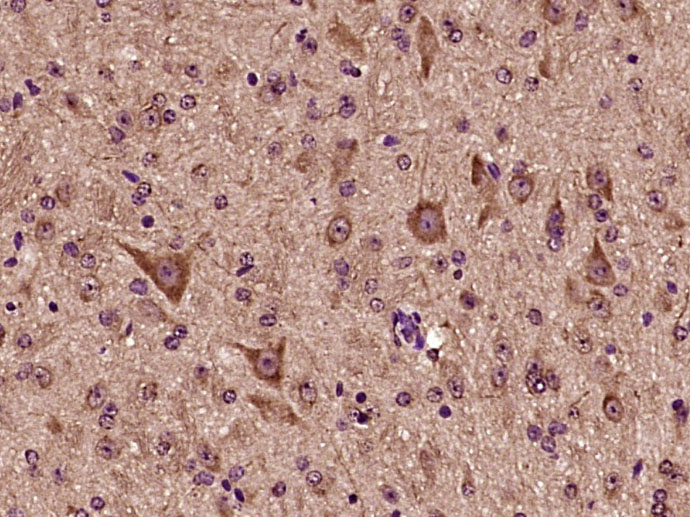NDOR1 Rabbit pAb
NDOR1 Rabbit pAb
- 产品详情
- 实验流程
- 背景知识
Application
| IHC-P, IHC-F, IF |
|---|---|
| Primary Accession | Q9UHB4 |
| Reactivity | Mouse |
| Predicted | Human, Rat, Dog, Pig |
| Host | Rabbit |
| Clonality | Polyclonal |
| Calculated MW | 66763 Da |
| Physical State | Liquid |
| Immunogen | KLH conjugated synthetic peptide derived from human NDOR1 |
| Epitope Specificity | 51-150/597 |
| Isotype | IgG |
| Purity | affinity purified by Protein A |
| Buffer | 0.01M TBS (pH7.4) with 1% BSA, 0.02% Proclin300 and 50% Glycerol. |
| SUBCELLULAR LOCATION | Cytoplasm > perinuclear region. Concentrated in perinuclear structure. |
| SIMILARITY | In the C-terminal section; belongs to the flavoprotein pyridine nucleotide cytochrome reductase family. Contains 1 FAD-binding FR-type domain. Contains 1 flavodoxin-like domain. |
| Important Note | This product as supplied is intended for research use only, not for use in human, therapeutic or diagnostic applications. |
| Background Descriptions | This gene encodes an NADPH-dependent diflavin reductase that contains both flavin mononucleotide (FMN) and flavin adenine dinucleotide (FAD) binding domains. The encoded protein catalyzes the transfer of electrons from NADPH through FAD and FMN cofactors to potential redox partners. Alternative splicing results in multiple transcript variants. [provided by RefSeq, Mar 2012] |
| Gene ID | 27158 |
|---|---|
| Other Names | NADPH-dependent diflavin oxidoreductase 1 {ECO:0000255|HAMAP-Rule:MF_03178}, 1.18.1.- {ECO:0000255|HAMAP-Rule:MF_03178, ECO:0000269|PubMed:23596212, ECO:0000269|PubMed:28648056}, NADPH-dependent FMN and FAD-containing oxidoreductase {ECO:0000255|HAMAP-Rule:MF_03178}, Novel reductase 1, NDOR1 {ECO:0000255|HAMAP-Rule:MF_03178} |
| Target/Specificity | Low expression in brain, heart, kidney, pancreas, prostate and skeletal muscle. Highest levels in the placenta. Expressed in cancer cell lines including promyelocytic leukemia, HeLa S3, chronic myelagenous leukemia, lymphoblastic leukemia, Burkitt's lymphoma, colorectal adenocarcinoma, lung carcinoma, and melanoma G361. |
| Dilution | IHC-P=1:100-500,IHC-F=1:100-500,IF=1:100-500 |
| Storage | Store at -20 °C for one year. Avoid repeated freeze/thaw cycles. When reconstituted in sterile pH 7.4 0.01M PBS or diluent of antibody the antibody is stable for at least two weeks at 2-4 °C. |
| Name | NDOR1 {ECO:0000255|HAMAP-Rule:MF_03178} |
|---|---|
| Function | NADPH-dependent reductase which is a central component of the cytosolic iron-sulfur (Fe-S) protein assembly (CIA) machinery (PubMed:10625700, PubMed:15900210, PubMed:20802492, PubMed:23596212, PubMed:28648056). Transfers electrons from NADPH via its FAD and FMN prosthetic groups to the [2Fe-2S] cluster of CIAPIN1, another key component of the CIA machinery (PubMed:20802492, PubMed:23596212, PubMed:28648056). In turn, this reduced cluster provides electrons for assembly of cytosolic iron-sulfur cluster proteins (PubMed:20802492, PubMed:23596212). It can also reduce the [2Fe-2S] cluster of CISD1 and activate this protein implicated in Fe/S cluster repair (PubMed:28648056). In vitro can fully activate methionine synthase/MTR in the presence of soluble cytochrome b5/CYB5A (PubMed:12871938). |
| Cellular Location | Cytoplasm, perinuclear region {ECO:0000255|HAMAP- Rule:MF_03178, ECO:0000269|PubMed:10625700, ECO:0000269|PubMed:12871939}. Note=Concentrated in perinuclear structure. {ECO:0000255|HAMAP-Rule:MF_03178, ECO:0000269|PubMed:12871939} |
| Tissue Location | Low expression in brain, heart, kidney, pancreas, prostate and skeletal muscle. Highest levels in the placenta. Expressed in cancer cell lines including promyelocytic leukemia, HeLaS3, chronic myelagenous leukemia, lymphoblastic leukemia, Burkitt's lymphoma, colorectal adenocarcinoma, lung carcinoma, and melanoma G-361 |
For Research Use Only. Not For Use In Diagnostic Procedures.
Provided below are standard protocols that you may find useful for product applications.
BACKGROUND
This gene encodes an NADPH-dependent diflavin reductase that contains both flavin mononucleotide (FMN) and flavin adenine dinucleotide (FAD) binding domains. The encoded protein catalyzes the transfer of electrons from NADPH through FAD and FMN cofactors to potential redox partners. Alternative splicing results in multiple transcript variants. [provided by RefSeq, Mar 2012]
终于等到您。ABCEPTA(百远生物)抗体产品。
点击下方“我要评价 ”按钮提交您的反馈信息,您的反馈和评价是我们最宝贵的财富之一,
我们将在1-3个工作日内处理您的反馈信息。
如有疑问,联系:0512-88856768 tech-china@abcepta.com.























 癌症的基本特征包括细胞增殖、血管生成、迁移、凋亡逃避机制和细胞永生等。找到癌症发生过程中这些通路的关键标记物和对应的抗体用于检测至关重要。
癌症的基本特征包括细胞增殖、血管生成、迁移、凋亡逃避机制和细胞永生等。找到癌症发生过程中这些通路的关键标记物和对应的抗体用于检测至关重要。 为您推荐一个泛素化位点预测神器——泛素化分析工具,可以为您的蛋白的泛素化位点作出预测和评分。
为您推荐一个泛素化位点预测神器——泛素化分析工具,可以为您的蛋白的泛素化位点作出预测和评分。 细胞自噬受体图形绘图工具为你的蛋白的细胞受体结合位点作出预测和评分,识别结合到自噬通路中的蛋白是非常重要的,便于让我们理解自噬在正常生理、病理过程中的作用,如发育、细胞分化、神经退化性疾病、压力条件下、感染和癌症。
细胞自噬受体图形绘图工具为你的蛋白的细胞受体结合位点作出预测和评分,识别结合到自噬通路中的蛋白是非常重要的,便于让我们理解自噬在正常生理、病理过程中的作用,如发育、细胞分化、神经退化性疾病、压力条件下、感染和癌症。






